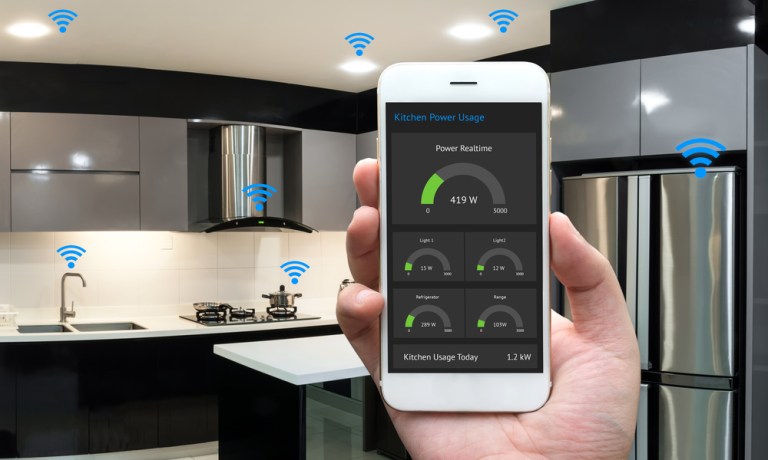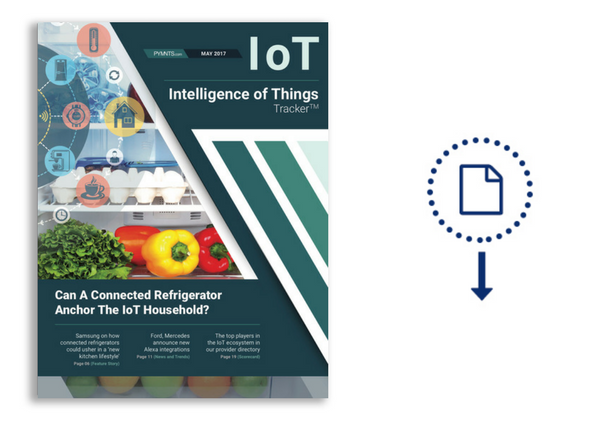Can A Connected Refrigerator Anchor The IoT Household?

It’s sure to guarantee bragging rights at cocktail parties, but how transformative can a smart refrigerator really be? The latest Intelligence of Things (IoT) Tracker™ digs into AI-infused appliances with Yoon Lee, SVP of Samsung Electronics America. Lee believes that a smart fridge become the backbone for a ‘new kitchen lifestyle’ and has the fridge to prove it. That, all of the “smartest” connected trends and a directory of 179 IoT players, inside the Tracker.
The refrigerator has long been perhaps the most used and visible household appliance. In many households, the refrigerator acts as a bulletin board, a photo album and a family planner, among other makeshift solutions. And, of course, as a place to keep food fresh. These days, the refrigerator may be developing its own device envy.
With manufacturers introducing built-in IoT connectivity that can help refrigerators communicate with smartphones and even neighborhood grocery stores, this household appliance could be headed for its most significant upgrade yet. With the growth of the IoT ecosystem, connectivity will be introduced to numerous devices in over the next few years. According to a recent report, there will be an estimated 20.4 billion IoT devices on the market by 2020.
As manufacturers equip their products with greater connectivity, previously standalone appliances are due for a facelift. With new abilities and functionality, standard household machines like refrigerators are poised to change how modern kitchens and households operate.
In a recent interview, Yoon Lee, SVP of product innovation for Samsung Electronics America, told PYMNTS that these connected capabilities are so powerful that they are causing a “paradigm change” for familiar household items. The introduction of connectivity, Lee explained, is causing both families and manufacturers to change long-held perceptions of the refrigerator.
‘The new kitchen lifestyle’
Each room in the house has a specific function, right? True — but those functions can evolve. As Lee sees it, the role of the kitchen has shifted dramatically over the years, from a working area to a social one.
“The purpose of kitchen has evolved from a space for preparing food to become a space for preparing and serving food as well as entertaining both your family and guests,” he said.
With the kitchen as a home’s central hub — what Lee refers to as “the new kitchen lifestyle” — he said it makes sense to introduce more connectivity to the space. Samsung sees the refrigerator as the optimal platform to offer this connectivity.
The refrigerator’s size has a big impact on this. Because refrigerators normally take up more space than other devices, they naturally become part of a kitchen’s central focus. They also stand apart from other devices because they’re always running, keeping food fresh. And, of course, household members use them daily while preparing meals or grabbing a snack.
“Within the connected kitchen, a connected refrigerator could be the next platform for serving the new kitchen lifestyle,” Lee said.
And as modern consumers rejigger the role of their kitchens, Lee said manufacturers should follow suit, reimagining appliances themselves.
To that end, Lee said that Samsung is undergoing a shift, treating the refrigerator as a software platform instead of as a hardware product. In this way, the company can gain insights into consumer behaviors from data tools, using the data to update the devices’ operating systems and informing new generations of refrigerators.
Rethinking the grocery trip
Samsung’s Family Hub offers a potentially clutter-killing touchscreen display that allows a family to sync calendars, share and display photos, write personal notes, and play music via services like Pandora.
Beyond adding new functionality, Lee pointed out, the fridge has several features that could change the way consumers shop for groceries. For example, the device offers a built-in camera that can display the refrigerator’s contents on smartphones, a convenient reference for shoppers as they stroll stores aisles trying to remember whether a particular item needs replacement. Consumers can also use the fridge’s built-in screen to drag expiration dates to items and then receive alerts as expiration dates approach.
And for consumers who want to skip a visit to the brick-and-mortar store, the refrigerator also comes with Groceries by Mastercard, a built-in feature that allows users to find grocers nearby, create a shopping list and order and pay for their items. The service can also connect with delivery services like FreshDirect or ShopRite from Home.
“You can initiate the purchase process regardless of your location,” Lee said.
Whatever features individual consumers actually choose to use, building greater connectivity into refrigerators will enable these devices to do far more than any previous generation. New levels of connectivity will enable the refrigerator to play a central role in planning a food shop, from start to finish.
Smarter steps to connecting smarter homes
To date, Lee said the Samsung Family Hub refrigerator has been in use in only a few households because the technology is relatively new to the scene. They also come at starting price of $3,500, which could put it out of many consumers’ budget.
But, Lee said, Samsung intends to gather information on how the early adopters of the smart refrigerator interact with the system and look for ways to improve it before expansion. Having the device tested by a smaller group of tech-savvy consumers will ultimately inform how other consumers eventually get on board, he said.
Still, just as it’s not wise to jam a refrigerator with perishables that can get lost in the shelves and emerge past their prime, Lee warned manufacturers not to overload the device with too many connected features.
While a smarter refrigerator might offer several new features that are designed to help consumers, he cautioned that these features could end up being less practical than more distracting if consumers aren’t ready to use them.
“The hardest thing is not to invent or to introduce new technology,” Lee said. “The hardest thing is to ask people to change their behavior. People only change their behavior if they see benefits to it.”
Reimagining the refrigerator as a software platform will help manufacturers like Samsung gain new data insights into their customers’ behaviors, said Lee. And this data can help the companies find the right way to introduce new connected features into products — refrigerators, as well as others.
Designing the kitchen of the future
In addition to helping customers stay on top of their food and ingredient inventories, Lee said he envisions a time when grocery replenishment and kitchen assistance, like setting oven temperatures, will become more seamless thanks to connected kitchen technology.
“Our vision is that connected technology could act as your sous chef,” he said.
Beyond smart kitchen technology, Lee sees several other opportunities for IoT technology to be integrated into household devices. He pointed to a connected clothes dryer that can alert a user when it is finished, or, if the dryer realizes that the consumer isn’t in the house, it can run on tumbler mode for 15 to 20 more minutes to prevent clothes from getting wrinkled.
“There are a lot of things that we can enable,” Lee said. “These solutions basically put a maid or an assistant in the home that can make your life a lot more enjoyable.”
With this level of connected assistance on the horizon, it may be a good time for families to consider stocking up the fridge and retiring those archaic magnets.
. . . . . . . . . . . . . . . .
To download the May edition of the PYMNTS.com Intelligence of Things Tracker™, click the button below …
About the Tracker
The PYMNTS.com Intelligence of Things Tracker™ showcases companies that are leading the way in all aspects of the Intelligence of Things. Every month the Tracker looks at what these companies are doing across the ecosystem and in several categories, including personal, home, retail, transportation, wearable, mobile, infrastructure, data and more.
